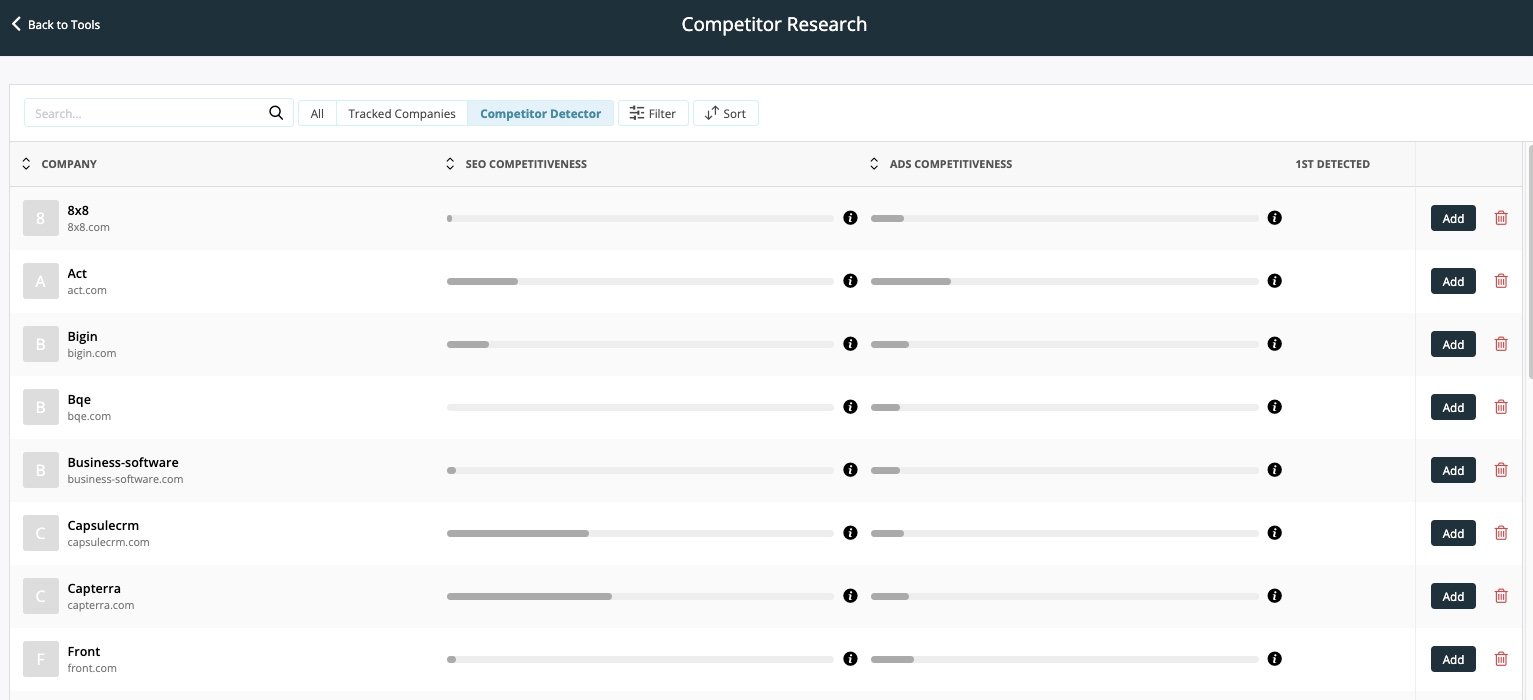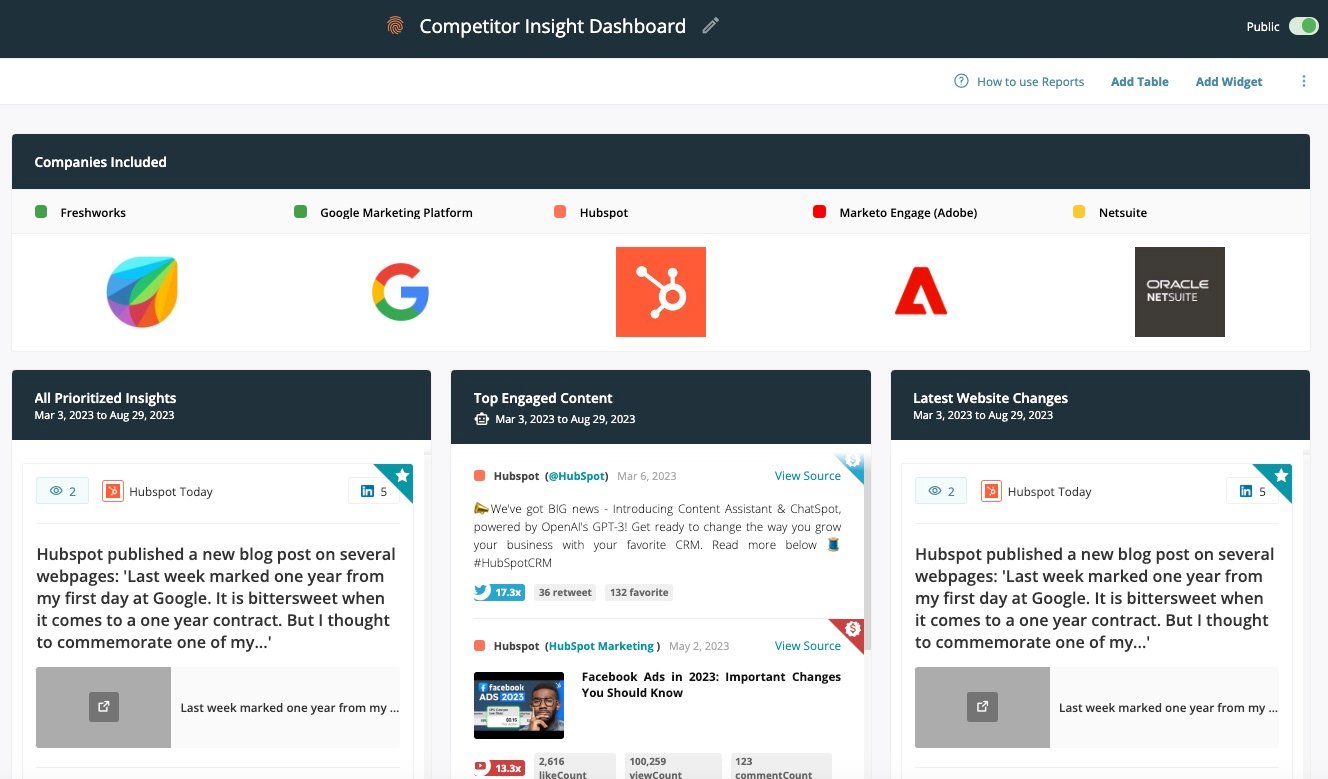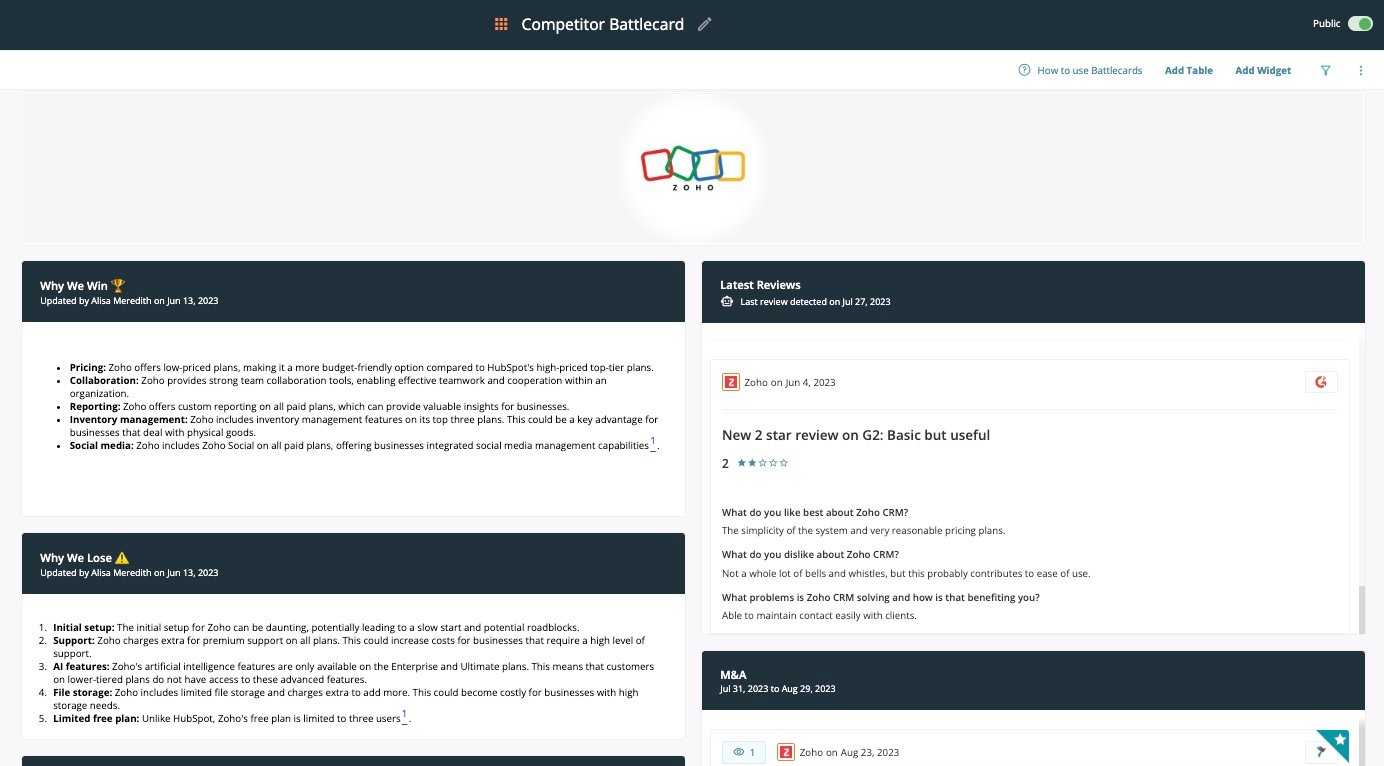Identifying Patterns in Market Trends with Real-time Intel to Drive More Sales
Knowing everything happening in your industry at every moment would be great. But unless your industry is tiny, it’s not practical. What makes more...
Want more from competitive intelligence? First, make sure you're getting all the potential benefits. Then maximize your program for even better results!

No matter your role—sales, marketing, product, or even the C-suite—there’s one essential business truth you’ll inevitably have to grapple with: the competitive landscape is a complicated place.
Every day, professionals like you are building and executing a strategy, only to pivot at the last hour due to an unexpected competitor move.
So how can you keep up?
With competitive intelligence.
Competitive intelligence provides data-driven insights—along with the context to understand them and make them actionable.
With it, you can respond proactively to shifts in your market, increase your competitive advantage, and beat your goals more soundly than ever.
Yes, the potential benefits of competitive intelligence are vast. Below, we’ll explore what it entails, along with practical tips and advice to help you make the most of it.
Competitive intelligence is the process of gathering and analyzing data about other companies’ activities and strategies with the goal of better understanding your competitive landscape.
It’s similar to market intelligence, which focuses primarily on understanding your target customers’ preferences and behavior. As such, the two often go hand-in-hand.
While it’s often associated with sales, competitive intelligence actually provides key information for almost every department in your organization. It can influence company decision-making, and help you stay ahead of the competition.
We’ll explore more about how specific teams can use competitive intelligence later in the article.
Depending on your role, the way you use competitive intelligence may vary. But whatever your role, if you want to achieve (or even surpass) your business goals, you’re going to need solid competitive intelligence.
Competitive intelligence can help you:
We’ll explore each of these in more detail below.
Competitive intelligence can help you spot and respond to shifting trends in your niche, based on the activities of your competition.
Here’s how it works.
Imagine you’re running a SaaS startup in a very competitive space. While you’ve been growing your footprint over time, you have several strong competitors to contend with. So, to compete more effectively, you regularly do competitive research and analyze the data.
Because you’re keeping up with your competitors, you’re able to spot a critical trend: their prices are all going up—and you’re now selling one of the most cost-effective products in your space.
Now, you can do two things:
Because you’ve been gathering competitor data over time, you can spot key trends in your space and take advantage of them, setting yourself apart from your biggest rivals.
Competitive intelligence can also help you learn from the past, both to position yourself for growth and prepare for future challenges.
How? By collecting and analyzing competitive data consistently over time.
This enables you to:
The types of challenges you might anticipate are as diverse as your competitors. For example one rival adjusts their prices on a seasonal basis, while another always announces new products or services with a big promotion at the end of the year.
The more regularly you track competitive insights and record your findings, the better you’ll be able to anticipate their next move and plan accordingly.
The best competitive intelligence is targeted to support your goals. And that means more than collecting a high volume of data. It also means collecting the right data, which aligns directly with your most important KPIs.
Why?
Simple—because this enables you to benchmark your performance against competitors, in a way that supports your business goals.
Here’s an example.
Let’s say you have a long-term business goal of improving your conversion rate by attracting more qualified leads. As part of this goal, one of your KPIs is to improve your average customer rating to 4.5 stars out of five.
If you achieve this KPI, will it actually improve your standing versus your competitors?
Well, that depends. To know for sure, you’d want to compare your achievement to your top competitors. You could compare related KPIs such as:
This information gives you more context with which to understand your success relative to your market. For example, if your competitors all have an average 4.5 star rating, but twice the volume of reviews, you probably still have some work to do to see a big result.
With the right competitive insights, you can set more competitive goals, and understand the real impact of your progress more thoroughly.
You’re probably already researching the competitors you know about—but what about the ones you don’t? A thorough competitive intelligence strategy accounts for both—making you aware not just of your stiffest competition, but also emerging threats in your space.
An emerging threat generally meets one of two criteria. It’s:
Here are a few ways to identify them:
Want some more tips on identifying these emerging threats? Check out our blog.
 Kompyte's "Competitor Detector" tool can surface new companies ranking for and bidding on your keywords.
Kompyte's "Competitor Detector" tool can surface new companies ranking for and bidding on your keywords.
Finally, competitive intelligence can help you identify new opportunities, like new customer segments you aren’t targeting, or soon-to-be-in-demand services.
Here’s an example.
Let’s say you run a boutique ad agency. As part of your strategy, you regularly do competitive research on all the major and emerging players in your space. Then, you use what you learn to sharpen your pitch and your service offerings.
Because of this research, you know that a few of your rivals have recently launched a popular new service, AI copywriting. And since you’ve seen an uptick in interest for those services, you can’t afford to ignore it.
You have two choices:
Without competitive intelligence, you might not have known about this until after most of your competitors had jumped on it. And then you would have lost ground, and found yourself racing to catch up. But since you learned about it early, you can create a proactive strategy.
In the same way—by gathering data about many different competitors—you can use competitive intelligence to stay up-to-date on the latest developments in your market.
Competitive intelligence can undoubtedly deliver enormous benefits. But how do you make sure you realize those benefits? By making these crucial competitive insights accessible to everyone who needs them.
You can do this by creating functional reports—reports that are up-to-date, accessible, and easy to understand.
Here are some basic principles to follow to make sure all your reports are helpful to everyone who reads them:
This doesn’t have to be labor-intensive. Once you know what you want your reports to include, with the right tools, you can automate much of this process.
For example, here’s a Competitor Insights report from Kompyte:

Here, the tool automatically aggregates the latest updates about each competitor, including:
Because Kompyte aggregates this information in a standardized, easy-to-digest way, teams can focus less on building and interpreting the report, and more on putting their learnings into action.
Once you know what your reports should look like, you can standardize and automate the process of creating and updating them with your preferred tool. Then, each team can get the information they need more efficiently.
Each team in your organization faces unique challenges in reaching business goals. And when it comes to competitive intelligence, they’re each likely to ask different questions.
That means that, to make the biggest impact with your competitor insights, you’ll need to create tailored reports aligned to each of their needs. See this article for detailed information about the essential reports your teams need (with examples). For an overview, keep reading.
Competitive research empowers your sales team to close more deals. How? Because it tells them two important things:
Help them put this knowledge into action by distilling it into competitor-specific Battlecards.
Battlecards equip your sales team with the powerful messaging they need to handle objections, answer detailed questions, and more. With competitive research, you can anticipate customer objections and address them in advance, so nobody gets caught unprepared.
Here’s an example of one competitor Battlecard from Kompyte:

It clearly outlines the Battlecard owner’s strengths and weaknesses against that competitor, along with recent feedback to support each point.
Curious about Battlecards? Check out our blog to discover the nine essential sales Battlecards every Sales team needs—with examples!
Your product team has the essential task of creating and maintaining your product roadmap. They identify gaps and leverage weaknesses and trends to help your products stay competitive.
A competitive intelligence report can help them do all of this, as long as it focuses on the most relevant data points.
These include:
Your product team can then use this data to respond proactively, by planning competitive product updates, adding in-demand features, or adjusting your pricing strategy.
Your marketing team plays a crucial role in achieving your business goals. Their activities help to maintain your customer funnel, attract leads, and establish your brand messaging. But to do it effectively, they need to understand what other influential voices in your space are saying.
That’s where competitive intelligence comes in. An effective marketing competitive intelligence report paints a detailed picture of each competitor’s marketing strategy.
For example:
With these insights, your marketing team can craft more powerful product positioning, create impactful campaigns, and attract more leads for your sales team to convert.
While it may not seem obvious, competitive intelligence can produce enormous benefits for your HR team. How so? It gives them key insights into which roles are in demand, and what makes those offers attractive to top talent.
Here are some key data points to include in your HR competitive intelligence report:
Leadership teams define strategic change, assess your brand’s position in the market, anticipate competitor strategy, and guide the organization toward long-term growth.
Competitive intelligence gives executives the context they need to make these crucial decisions with confidence. It keeps them up-to-date on competitor strategies, provides high level insights, and helps them be proactive.
Here are a few key data points for an executive competitive intelligence report.
Learn more about crafting these and other team-specific competitive intelligence reports on our blog.
Incorporating competitive intelligence into your strategy carries many potential benefits. But it also requires consistency, and dedicated resources.
That means you have a few options:
So how do you know which is right for you? This is typically a question of scale, goal, and resources.
A specialist in competitive intelligence or data analysis can help, but if you can afford to automate your program, a Product Marketing Manager, data analyst, or someone else can own the maintenance of your program in about an hour a week.
This frees you to spend more time putting your findings into action, and enables your competitive intelligence analyst (if you have one) to go even more in-depth with their research.
Kompyte, for example, can aggregate competitor data, deliver it in easy-to-understand reports, and even alert you automatically in Slack to the latest updates.
.jpg?width=745&height=501&name=Alert%20in%20Slack%20(1).jpg)
With the right tool, you can track dozens of competitors and gain relevant insights in just one hour a week.
Sound too good to be true? See for yourself.
Competitive intelligence is a never-ending journey. But one that's a worthy investment of your resources.
It has the potential to enhance efficiency, conserve precious time, and, most importantly, stay anchored to data that drives their objectives and fosters informed decision-making processes.
Get these benefits by staying connected to each team’s needs and insights, and building tailored competitive intelligence reports to help them overcome their unique challenges.
When you fully realize the benefits of competitive intelligence, your business is equipped to anticipate and adeptly navigate any shifts in your competitive landscape.
Knowing everything happening in your industry at every moment would be great. But unless your industry is tiny, it’s not practical. What makes more...
Knowing where you stand in the market is critical, check out these 7 tips for benchmarking your CI. Read our latest article for a benchmarking...
Competitor Analysis Report (Part VI): Evaluate external market forces beyond the competition and develop action points for your company to win in...
Be the first to know about new B2B SaaS Marketing insights to build or refine your marketing function with the tools and knowledge of today’s industry.